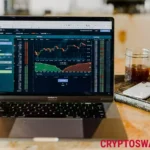The stochastic oscillator indicator, often simply called the “stochastic” or “Stoch,” is a powerful momentum indicator used to identify potential entry and exit points in the market. It helps traders determine when an asset, such as a cryptocurrency, is overbought or oversold.
Originally developed by George C. Lane in the 1950s, the stochastic oscillator indicator was designed to compare a particular closing price of an asset to a range of its prices over a certain period. While the indicator’s mathematical foundation initially made it less accessible, advancements in trading technology have simplified its use. Today, it’s a favorite among both beginner and professional traders.
Although the stochastic oscillator indicator was first used in traditional stock trading, it has also found significant popularity in the crypto trading world, especially among day traders. Its ability to highlight short-term price momentum makes it particularly useful for volatile markets like cryptocurrency.
In this guide, we’ll break down everything you need to know about the stochastic oscillator indicator, how it works, how to use it effectively, and why it’s a must-have in your technical analysis toolkit.
While this tool may not be available in standard wallet apps or basic exchange interfaces, you can easily access it on platforms like TradingView. Many major crypto exchanges now support TradingView integration, allowing traders to enable and customize the stochastic oscillator indicator directly on their trading charts.
What Is a Stochastic Oscillator Indicator?
The stochastic oscillator indicator is a widely used technical analysis tool that measures the momentum of an asset’s price movements, especially in volatile markets like cryptocurrencies. It helps traders identify overbought and oversold conditions by comparing a coin’s closing price to its price range over a specific period.
According to its creator, George C. Lane, the stochastic oscillator “doesn’t follow price; it doesn’t follow volume or anything like that. It follows the speed or momentum of the price.”
Put simply, the stochastic oscillator indicator shows when traders are aggressively buying a coin (overbought conditions) or heavily selling it (oversold conditions).
While it doesn’t directly predict whether a market is bullish or bearish, it provides valuable insights that can help you determine the current market sentiment.
Structure of a Stochastic Oscillator Indicator
The stochastic oscillator indicator is simply two lines that indicate buy and sell momentum breaks over a given period of time. One line is called %K, and the other is called %D. If everything is normal, then the up-and-down pattern of these lines will closely resemble the price chart.
Unlike price charts that usually use fixed colors like red or green, the stochastic oscillator indicator doesn’t have a fixed color scheme; you can customize the line colors according to your preference. It is displayed as a percentage, ranging from 0% to 100%, with key threshold levels at 80% for overbought conditions and 20% for oversold conditions.
From these two lines:
- %K reflects the actual value of the oscillator for each trading session.
- %D reflects the three-day simple moving average of the %K line.
The %K line is faster, while the %D line is slower. Traders typically focus more on the %D line to interpret meaningful signals.

It consists of the following components:
%K line: This is the main line of the oscillator, and it is calculated as the current closing price of the security divided by the highest high and lowest low of the security over a specified number of periods.
%D line: This is a moving average of the %K line, and it is used as a signal line to generate buy or sell signals.
Overbought and oversold levels: These are predetermined levels, typically set at 80 and 20, that indicate when security may be overbought (priced too high) or oversold (priced too low).
Crossovers: A buy signal is generated when the %K line crosses above the %D line, and a sell signal is generated when the %K line crosses below the %D line.
Understanding the Stochastic Oscillator Indicator
As mentioned earlier, out of the two lines in the stochastic oscillator indicator, the %D line is the one traders should focus on the most. The %D line represents the simple moving average of the %K line and is more reliable for identifying potential buy and sell signals in crypto trading.
When the value of the stochastic oscillator indicator falls to 20% or below, it typically signals an oversold condition, a strong buying opportunity. On the other hand, when the indicator reaches 80% or higher, it suggests the market is overbought, which is often a good time to consider selling.
When the crypto price is high, the stochastic value usually moves higher as well. Buying cryptocurrency at this stage is risky, as it often marks a peak point where many traders start selling their holdings. Conversely, when the crypto price drops, the stochastic value also goes down, signaling a potential buying opportunity.
It’s important to note that the stochastic oscillator indicator reflects the momentum of price movements within a specific time frame. However, momentum in one time frame doesn’t guarantee that the same trend will continue in the next.
For example, let’s assume you’re analyzing a coin on an hourly chart:
- At one hourly time break, the price is $10 and the stochastic value is 70%.
- In the next hour, the stochastic drops to 55%, and the price falls to $9.58.
- In the following hour, even if the stochastic value rises sharply to 70% again, the price might not return to $10.
This shows that a rising stochastic oscillator indicator doesn’t always mean a price increase. However, if you buy a coin when the stochastic value is low (say, 15%), and the value climbs to 70%, you’re likely to see some profit, even if the price doesn’t fully recover to its earlier high.
Take a look at the USDT/DOGE example below:
- When the stochastic value is 73.96%, the price of DOGECOIN is $0.142.
- After a few days, the stochastic drops to 4.75%, and the price falls to $0.075.
- Later, the stochastic value rises again to 83.41%, but the price only climbs to $0.10, not back to $0.142.
This illustrates that while the stochastic oscillator indicator can show rising momentum, it doesn’t guarantee a return to previous price levels. Instead, it gives a probability-based signal for market momentum, which can help traders make more informed decisions.

Limitations of the Stochastic Oscillator Indicator
While the stochastic oscillator indicator is a popular tool for identifying market momentum, it does come with several limitations that traders should be aware of.
One of the most common issues is that it can generate false signals, especially in range-bound or choppy market conditions. During periods of sideways movement, the indicator may frequently flash overbought or oversold signals without any significant price movement, leading to poor trade entries or exits.
In highly volatile markets, relying solely on the stochastic oscillator can be risky. Sudden price spikes or crashes can cause the indicator to behave unpredictably, making it less effective for real-time decision-making.
Another major limitation is its unsuitability for newly launched cryptocurrencies. Since the stochastic oscillator requires historical price data to function accurately, coins without sufficient trading history may produce unreliable or misleading results.
Additionally, the stochastic oscillator indicator can vary across different exchanges. For the same cryptocurrency, the indicator readings may differ depending on exchange-specific price data, which can create confusion for traders using multiple platforms.
Lastly, there is a possibility of signal delays. In fast-moving markets, even a slight lag in the indicator’s response can result in missed opportunities or significant investment losses.
Conclusion
The stochastic oscillator is a powerful tool that helps traders assess the momentum behind a cryptocurrency’s price action. By identifying overbought and oversold conditions, it can offer valuable buy and sell signals. However, it should never be used in isolation.
For the most reliable results, traders should always combine stochastic oscillator signals with other forms of technical analysis, such as support and resistance levels, volume indicators, Bollinger Bands or RSI, as well as fundamental analysis.
In conclusion, the stochastic oscillator indicator is highly useful for both beginner and experienced cryptocurrency traders. It offers clear insights into price momentum and can enhance decision-making when used as part of a well-rounded trading strategy.
Note: This article is part of the “Understanding the Crypto Trading Chart” series. More articles keep coming.







